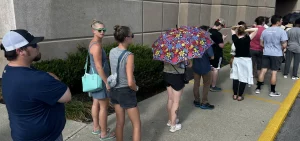News
Early voting on Issue 1 in Ohio ends with no waits in rural areas and long lines in urban counties
By: Jo Ingles | Statehouse News Bureau
Posted on:
COLUMBUS, Ohio (Statehouse News Bureau) — Early voting for Ohio’s August 8 election is over. Now, it comes down to Tuesday when Ohioans will decide Issue 1, the statewide proposed change to the constitution that would make it harder to pass future amendments and would significantly raise the requirements for groups to get to the ballot in the first place.

About two dozen volunteers crowded into a shelter house at a park in Delaware County – a reliably Republican county that has gotten a little less red over the last few years – as Ohio Democratic Party Chair Liz Walters rallied with them before they headed out for last minute door to door effort to get voters to vote against Issue 1. A little while later, Walters herself did some door knocking in Franklin County, a Democratic party stronghold.
Meanwhile, a large float with the message Yes on 1 was parked in the lot of the board of elections as the Delaware County Republican Party was holding a rally with GOP state leaders from that area. And a “Pray the Rosary” rally featuring the star of the movie “The Sound of Freedom” and former three-star general and Trump adviser Michael Flynn was held in Cincinnati.
Leading up to this weekend, the official pro-Issue 1 campaign has spent more than $9.5 million on radio and TV ads, while the anti-Issue 1 campaign has spent $12.5 million. Half of the more than $21 million has been spent in the week before the election.
What was initially thought by some to be a sleepy summer special election that wouldn’t attract much turnout has turned into anything but.
Early voting totals show more than double the number of people who voted at the same time in last year’s contentious May primary for US Senate and governor have cast ballots. And more than five times as many Ohioans have already voted early when compared with last August’s legislative primary.
Ohioans in both cities and rural areas are voting early. But all voting hasn’t been equal.
Smaller counties have had virtually no wait. But there have been long lines at early voting centers in Ohio’s largest counties: Hamilton, Cuyahoga and Franklin County. Meghan Hayes of Columbus was one of the voters in a line that snaked all the way around the old department store that houses Franklin County’s early voting center.
“I just want to make sure that this election doesn’t go by without anyone paying attention. In some ways it’s kind of nice to see the line of people who care but it’s also, this is ridiculous,” Hayes said.
Aaron Sellers, public information officer for the Franklin County Board of Elections, said voters were patient.
“I mean it’s hot, but I’ve not seen any issue or anybody who is upset. They are here and they probably knew that there was going to be a line and we are working through them,” Sellers said.
Still, Jen Miller with the League of Women Voters of Ohio said changes need to be made so voters are not having to stand in long lines in August sun and heat.
“Voting should not have to be a feat of endurance, but it’s especially a concern in August when we have hot weather,” said Miller.” People are standing on the pavement. And we are concerned about people’s health and safety when the lines are long.”
Some voting rights advocates provided icy cold bottles of water to those who were waiting.
This August election wasn’t even scheduled until May. Republican legislators passed a law at the end of last year that did away with most August special elections.
The idea to raise the voter approval threshold for constitutional amendments from a simple majority to 60% and to require groups get signatures from all 88 counties to put amendments on the ballot was proposed in November.
It was originally targeted for the May primary ballot. When that effort failed, majority Republicans in the Ohio Legislature put it forward in August so it would be in place for the November election. That’s when voters will consider a constitutional amendment on reproductive and abortion rights.
The Ohio Supreme Court ruled the law banning most August special elections didn’t apply when state lawmakers were putting forward a constitutional amendment.
Polls open at 6:30 am Tuesday. Voters are advised to check where they should vote as many polling locations have changed. And in some areas, there is a shortage of poll workers so it’s possible there might be lines on Election Day too.

